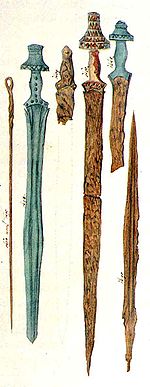
Back Ferepoka glavo Esperanto Spade dell'età del ferro Italian 철기 시대의 도검 Korean Меч железного века Russian

Swords made of iron (as opposed to bronze) appear from the Early Iron Age (c. 12th century BC),[citation needed] but do not become widespread before the 8th century BC.
Early Iron Age swords were significantly different from later steel swords. They were work-hardened, rather than quench-hardened, which made them about the same or only slightly better in terms of strength and hardness to earlier bronze swords. This meant that they could still be bent out of shape during use. The easier production, however, and the greater availability of the raw material allowed for much larger scale production.
Eventually smiths learned of processes to refine smelted iron and make steel. By quenching (making the steel hard and brittle) and tempering (removing the brittleness), swords could be made that would suffer much less damage, and would spring back into shape if bent. It took a long time, however, before this was done consistently, and even until the end of the early medieval period, many swords were still unhardened iron. Several different methods of swordmaking existed in ancient times, including, most famously, pattern welding.[1][2][3] Over time, different methods developed all over the world.